
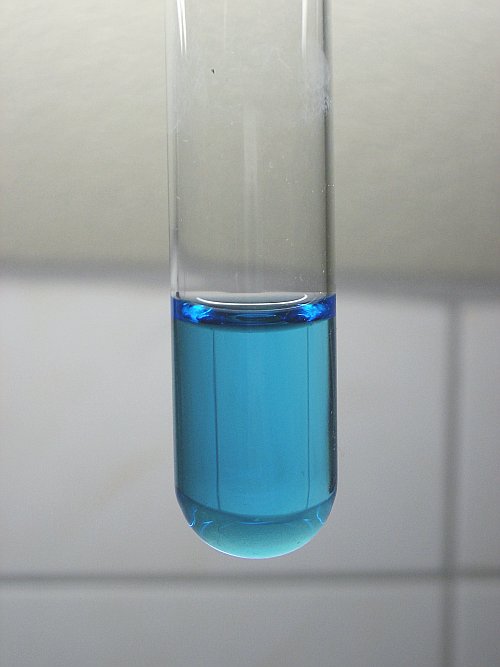

Aqueous solutions and precipitates of copper
In aqueous solutions, copper exists in the +1 and the +2 oxidation state. The +1 oxidation state is unstable as plain aqua ion and as such it does not exist. In combination with many other ligands, however, the +1 oxidation state is stable, but it is very prone to aerial oxidation. Oxidation state +2 is stable over the entire pH range, either as aqua ion, or as hydrous precipitate, or as complex. Copper (II) has a very rich aqueous chemistry and forms numerous complexes, both in acidic and in alkaline solutions. Especially the alkaline complexes frequently have beautiful royal blue colors. Copper (II) is slightly amphoteric. In strong alkaline solutions or at very low concentrations, copper forms the deep blue cuprate ion.
![]()
Oxidation state +1
This oxidation state certainly is not the most common oxidation state. Some compounds of copper in the +1 oxidation state are available commercially, but only the oxide, Cu2O, can be obtained and stored such that it remains pure and is not oxidized by oxygen from the air.
In aqueous solution, copper (I) only exists in the form of complex ions, with other ligands than water. With Cu+(aq) almost instantaneously disproportions to Cu2+(aq) and Cu(s). Copper (I) complexes can be made both in acidic and alkaline solutions.
Here, a solution of an ammoniacal copper (I) solution is shown. This solution contains ions Cu(NH3)2+(aq), together with excess ammonia. Copper (I) solutions usually are colorless.
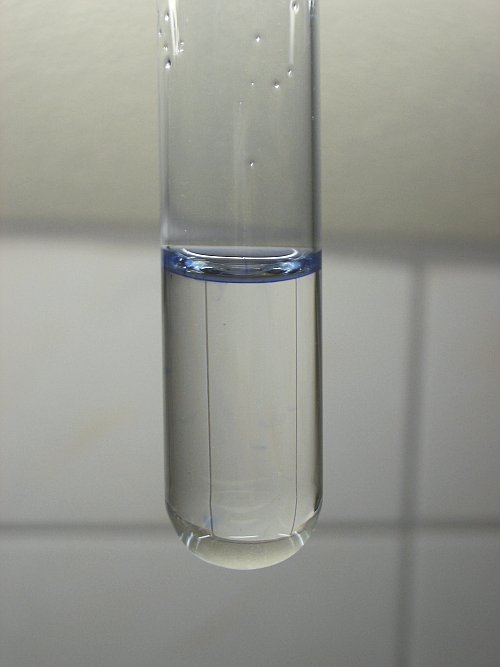
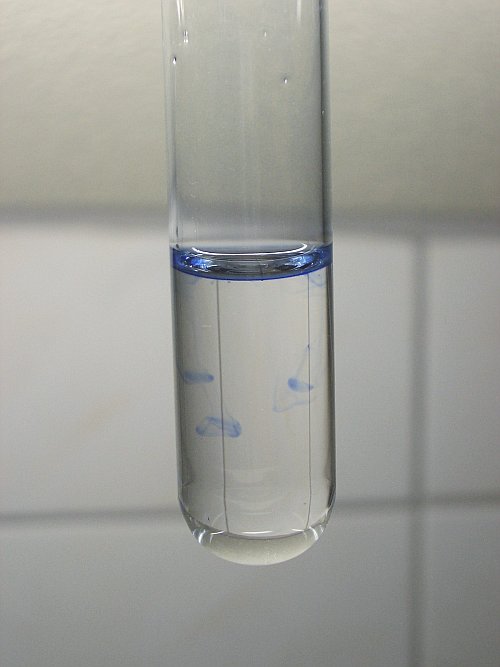
Both pictures show the same test tube, just a few seconds apart in time. These pictures show how easily such a solution is oxidized by oxygen from the air. The left picture shows the colorless solution, but the surface of the liquid already is blue and the glass of the test tube, above the liquid also is blue. When the test tube is shaken lightly, then one can observe blue curls going downwards. These are due to aerial oxidation at the surface of the liquid of the aqueous colorless Cu(NH3)2+(aq) to the deep blue aqueous Cu(NH3)42+(aq). Apparently the latter causes the density of the liquid to increase, such that the blue solution moves downwards in the liquid. If the liquid is left in contact with air for a longer time, then it becomes deep blue.
Remark: In order to show this colorless copper (I) solution, a slight excess amount of sodium dithionite was added to a deep blue solution of copper (II) sulfate in excess ammonia. Without the addition of this strong reductor, it simply is not possible to show a colorless solution of a copper (I) compound.
There can also be solutions of copper (I) in acidic solutions, such as the complex CuCl2–(aq). An extensive description of this ion and its properties is given here.
Although copper (I) complexes can be formed in strongly alkaline solutions, at really high pH, many of these complexes are not stable anymore. If e.g. a concentrated solution of sodium hydroxide is added to the colorless ammoniacal solution, as shown above, then a very finely divided bright yellow precipitate is formed at once. This precipitate is hydrous copper (I) oxide, or something like copper (I) hydroxide. Its precise composition is not totally clear, however. The best description of this compound probably is Cu2O·nH2O. It is a very nice compound with a beautiful saturated deep yellow color. The fact that such yellow precipitates can be produced from copper compounds is not known very well.
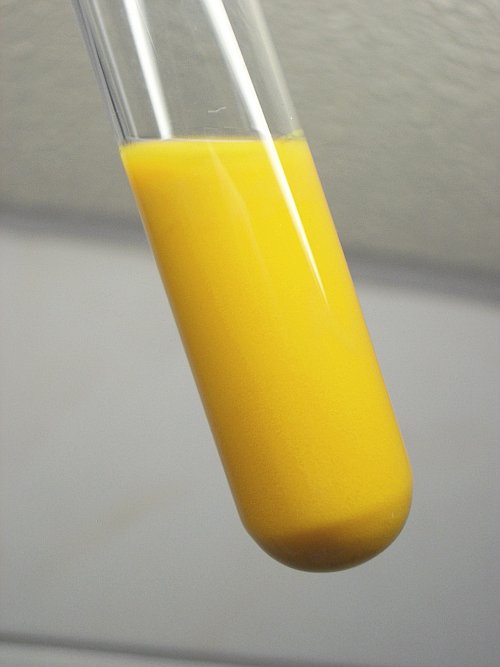
Another form of copper (I) oxide is known much better. This is the brick-red compound, formed by slow reduction of an alkaline complexed copper (II) solution. An example of this is the well known Fehling's reagent, which contains a tartrate/copper (II) complex in excess solution of sodium hydroxide. When a mild reductor (e.g. glucose, or glycerol) is added to such a solution, then a brick red precipitate is formed of very fine crystalline Cu2O. Formation of this precipitate takes a few hours at room temperature. The precipitate, formed in this way, is remarkably compact. When the test tube is shaken, then in a few seconds, most of the precipitate already has settled at the bottom again and only the finest particles still are in the liquid. Pictures of the brick-red copper (I) oxide are given here. The left picture shows the copper (I) oxide, shaken into the liquid, the right picture shows a compact precipitate, with the liquid decanted from this and the test tube kept upside down.
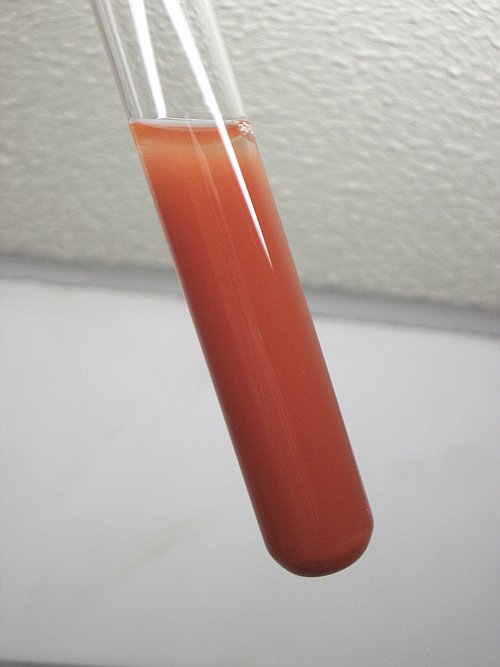
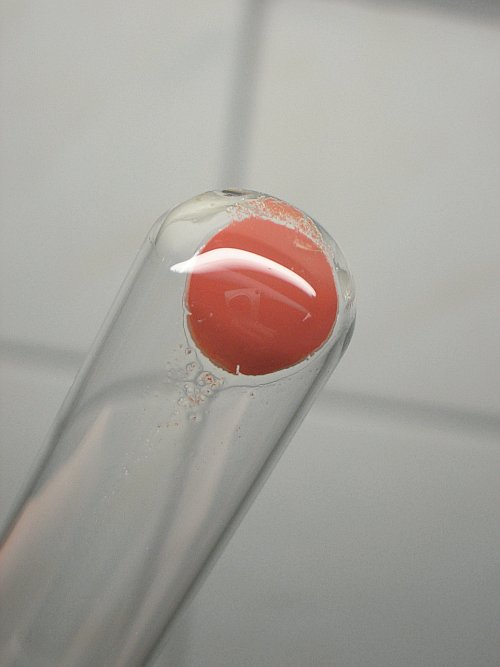
Remark: It is my personal observation, that the faster the process in which the copper (I) oxide is formed, the lighter the color. This observation about the color of copper (I) oxide, however, I could not confirm with texts from acknowledged text books.
So, when copper (I) oxide is formed instantaneously from a solution, such as on addition of sodium hydroxide to an ammoniacal solution of copper (I), then a bright yellow compound is formed. When the oxide is formed within a few hours, e.g. by reduction with glucose, then the oxide is brick-red. Intermediate colors can also be obtained. E.g. on addition of a solution of copper (II) sulfate to a warm alkaline solution of sodium ascorbate, a bright orange precipitate is formed. Formation of this orange compound is not instantaneous. First a dirty green precipitate is formed and it takes several seconds before it is bright orange.
![]()
Oxidation state +2
This is by far the best known oxidation state of copper and it also is the most stable one. In water, copper forms sky-blue aqua-ions Cu(H2O)62+(aq). This ion tends to hydrolyse somewhat in water, and when a solution of a copper (II) salt is allowed to stand for a long time, then the liquid has become a little acidic and a small amount of a basic copper salt has precipitated at the bottom.
A picture of a solution, containing plain aqueous copper (II) ions is given here:

When a solution of sodium hydroxide is added to such a solution of a copper (II) salt, then a bright blue precipitate of copper (II) hydroxide is formed. This is a crystalline solid, which is quite hard. When solutions of e.g. copper sulfate and sodium hydroxide of sufficient high concentration are added to each other, then the precipitate becomes so hard, that the particles hardly can be broken by violent shaking. The left picture shows the precipitate of Cu(OH)2, immediately after its creation, the right picture shows the same test tube after fairly violent shaking. As the right picture shows, the colorless solution of sodium hydroxide still is at the bottom, unmixed with the rest of the liquid. This shows that the precipitate has quite a strong structure.
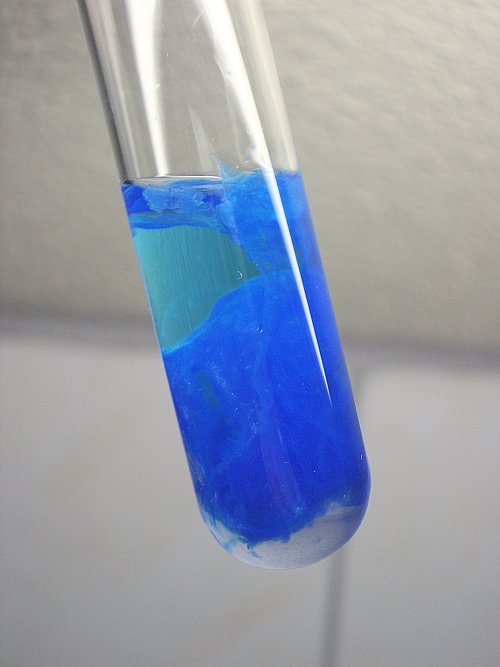
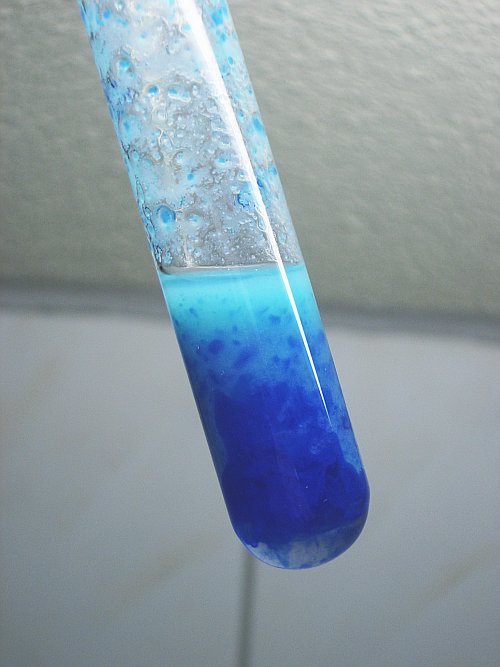
A remarkable property of copper (II) hydroxide is that it looses water, when it is heated, even if the precipitate is immersed in water! The following two pictures show the same test tube, with its contents heated to approximately 90 °C. All precipitate turns black from below (the source of the heat) and when the test tube now is shaken, the precipitate fairly easily breaks apart and all becomes black.
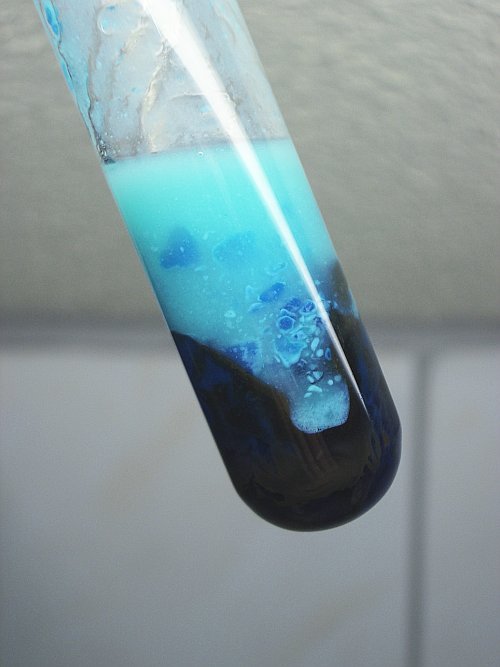
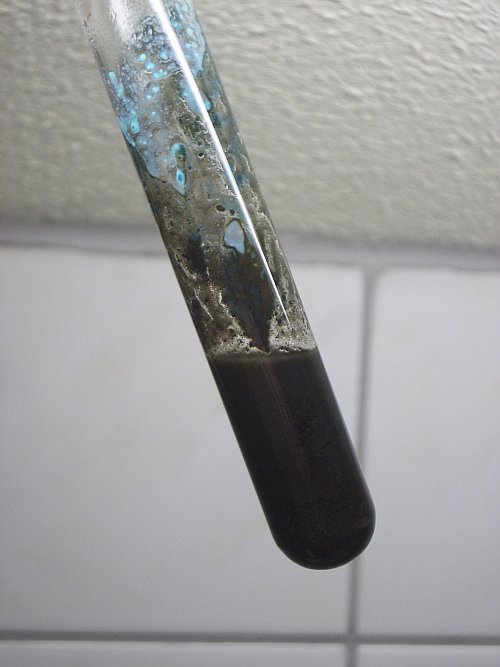
When a solution of sodium hydroxide is added to a hot solution of a copper (II) salt, then the black precipitate is formed immediately. The black precipitate (or better: very dark brown if observed very carefully), is copper (II) oxide, CuO.
When a solution of a copper (II) salt is added to a very concentrated solution of a hydroxide, then some cuprate is formed. This shows that copper (II) is slightly amphoteric. The cuprate ion remains in solution at very high concentration of the hydroxide, but it can also remain in solution at lower concentrations of hydroxide, but then the concentration of the copper must also be low. The following two pictures show the formation of a solution, containing the deep blue cuprate ion, Cu(OH)42–, sometimes formulated as CuO22–(aq).
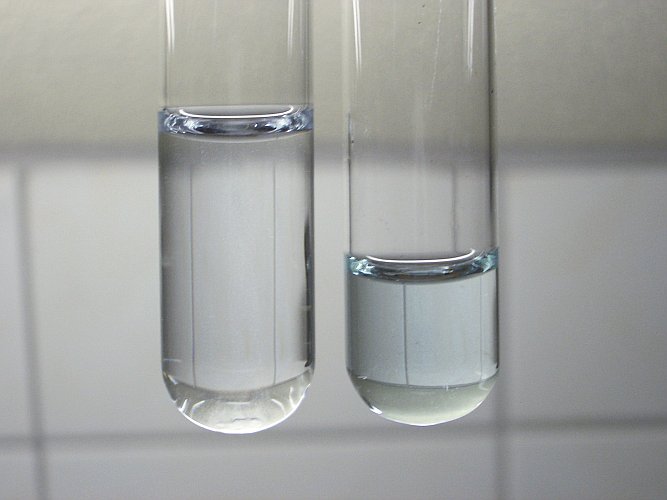
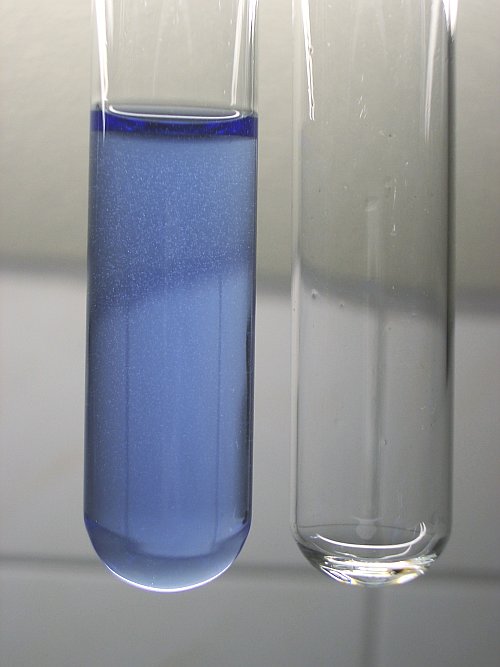
The left picture shows a moderately concentrated solution of sodium hydroxide and a very dilute solution of copper sulfate (right test tube with pale blue liquid). The right picture shows the result of adding the solution of copper sulfate to the solution of sodium hydroxide, combined with some shaking. The liquid is clear and has a nice blue color. When more copper sulfate would be added, then it would become turbid.
The following picture shows a more concentrated solution of the cuprate ion. It was prepared by adding solid copper sulfate to a very concentrated solution of sodium hydroxide and heating this solution, while shaking, for several minutes. As the picture shows, the color of the cuprate ion is nice deep blue. At the bottom, there is some solid copper (II) oxide. The explanation for the formation of this is given above.
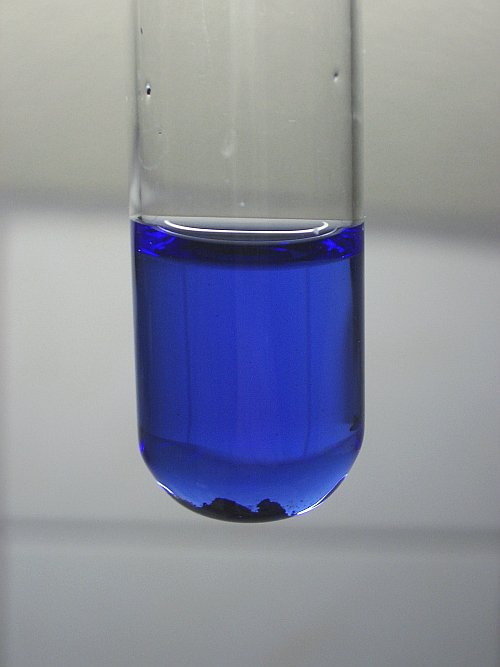
![]()
Alkaline complexes of copper in oxidation state +2
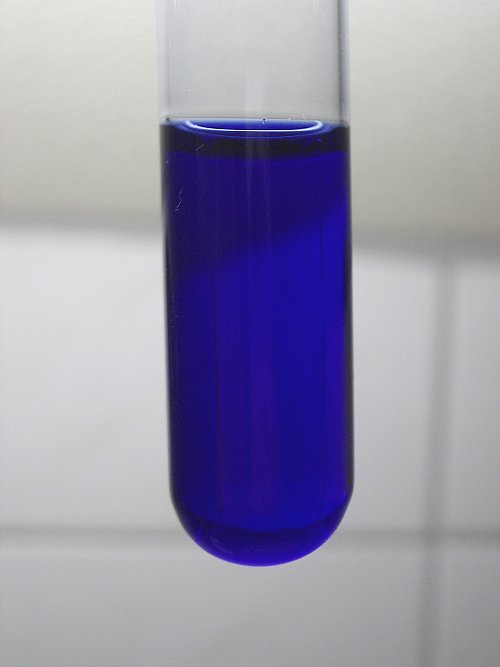 A
very typical and well known property of copper (II) is that it forms deep royal
blue complexes with many compounds in alkaline environments. The best known
example of this is the tetrammine complex of copper (II), formed by adding
excess ammonia to a solution of a copper (II) salt. Other such complexes,
however, can be formed, e.g. by adding copper (II) to an alkaline solution of
glycerol, glucose or sodium tartrate. At the left, a picture of a solution,
containing the complex ion Cu(NH3)42+(aq)
is given.
A
very typical and well known property of copper (II) is that it forms deep royal
blue complexes with many compounds in alkaline environments. The best known
example of this is the tetrammine complex of copper (II), formed by adding
excess ammonia to a solution of a copper (II) salt. Other such complexes,
however, can be formed, e.g. by adding copper (II) to an alkaline solution of
glycerol, glucose or sodium tartrate. At the left, a picture of a solution,
containing the complex ion Cu(NH3)42+(aq)
is given.
back to solutions/precipitates main page
back to miscellaneous main page